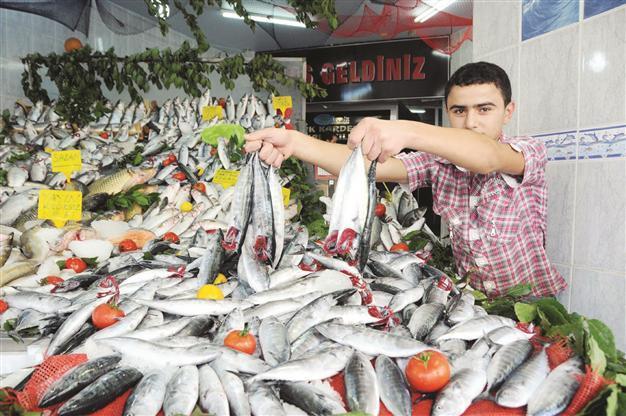Fruitful bonito season comes with debate over fishing depth
ISTANBUL

Tons of bonito caught by hand lines off Samsun, a Black Sea province, raises hopes for professional before the end of the annual fishing ban, which does not touch amateurs. DHA photo
A hopeful season for Turkish fishermen starts on Sept. 1, amid discussion of new restrictions further limiting the depths at which fish can be caught.Mustafa Mollaoğlu, a representative of a local fishing industry organization in the Black Sea province of Ordu, said fishermen expect to see a large bonito catch this year. This agrees with other forecasts, which are also signaling a large bluefish catch.
“We are very hopeful this season,” Mollaoğlu told Doğan news agency, noting that last year was not lucrative. Some 477,558 tons of fish were caught in 2011, according to official figures. Mollaoğlu called on his colleagues to fish responsibly, as illegal fishing has been destroying fishes’ habitats for years.
Last year, the allowable size limits for bluefish was increased to a minimum of 20 centimeters, in a bid to protect the species. This year, the ministry increased the depth limit for fishing with dragnet boats to 24 meters from 18.
Measures for sustainability
The aim of the new regulation was to provide sustainability, according to Durali Koçak, the general manager of the fishery directorate at the Food, Agriculture and Husbandry Ministry.
Between 86 and 90 percent of Turkish fish is caught using dragnet boats, he told Anatolia news agency. “Fishermen say that the new regulation restricts the catch, but it does not. It just regulates the kinds of fish that can be caught,” he said. The limit even extends to 50 meters, he said.
Ahmet Kıdeyş, head of the Sea Science Institute at Middle East Technical University (ODTÜ), agrees, saying dragnets unintentionally target protected fish species and marine plants, such as seahorses and sea grass. “Some 80 percent of the real targets of fishermen are at 24 meters or deeper. Fish closer to the shore are usually fingerlings, and they need to be protected,” he said.
Adnan Ayaz, another academic from Çanakkale’s Onsekiz Mart University, also supports the regulation. “We are risking the stocks of shore fish for bonitos and bluefish, but bonito can be fished at depths greater than 24 meters.”
However, Osman Kocaman, a fish exporter from Bandırma, a coastal town in the northwestern province of Balıkesir, disagrees, calling for more specific restrictions instead of an overall depth limit. Kocaman, who also chairs the local chamber of commerce, told the Daily News on the phone yesterday that some areas where fish lay eggs were totally closed to fishing, and that this was a better solution. Not only fishermen but also consumers would be negatively affected by a fish shortage, which is possible under the new regulation, because fish is an inexpensive source of protein, Kocaman said.
“People may have to pay high prices for fish, [even] in a year when there is plenty of it,” he said.
Supporting the size limit on bluefish, Kocaman also called for a ban on fishing the entrances of the Bosphorus Strait. Turkey’s fishery and aquaculture exports, which stand at around $400 million annually, might also be affected, he said.
















